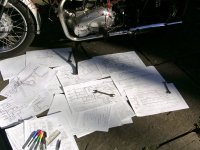flyerdon
XS650 Enthusiast
Last edited:
Add to that; the brake shoes tend to fall off when they've been setting wet. Not much fun if it happens when you're riding.

I checked it, it was as dry as a popcorn fart. Probably had never been serviced from what I saw.While you're at the rear wheel, you should probably service the drum brake. The cam needs to be lubed where it passes through the hub or the brake will squeal and squawk when applied. See post 3 .....
http://www.xs650.com/threads/how-difficult-is-it-to-replace-the-rear-drum-brakes.25632/
Yup.That's one hell of a heavy engine for it's size and I know I'll need help getting it back in. At 69, 150 lbs and 5'6", there's no way I could get that bugger back in.
 flyerdon.
flyerdon.... 2M expressed some concerns about an oil feed hole inside the bushing bore and that a longer bushing may block it. I inspected the hole thoroughly and could see no oil hole. There's a step inside the bore to stop the bushing from being driven in too far ...
My best guess is that if there is an oil feed hole in there, it's in deeper, past the step, so a longer bushing blocking it is of no concern. The step is about 11mm into the hole. That means a 12mm bushing will protrude about a MM out of the shaft when seated to the step ...
Hey, that sounds like a great idea, I never even thought of that but it sure makes sense, that frame weighs a whole lot less than the motor and I could probably do that myself, maybe with a bit of help from my honey-pie. Thanks a ton for that advice.When you get around to refitting the engine, lay the engine on its side on the floor and lower the frame onto it.
Nice to see another coming back to life.
